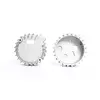Mobile:+86-311-808-126-83
Email:info@ydcastings.com
English
Optimizing Performance of Turbocharger Turbine Housing for Enhanced Engine Efficiency
Understanding Turbo Turbine Housing An Integral Component in Turbocharger Systems
Turbocharger systems have become a cornerstone in modern automotive engineering, significantly enhancing engine performance and efficiency. Among the components that contribute to the effective functioning of turbochargers, the turbo turbine housing plays a pivotal role. This article delves into the intricacies of turbo turbine housing, exploring its design, functionality, and significance in optimizing engine performance.
What is Turbo Turbine Housing?
The turbo turbine housing is the component that encases the turbine wheel of a turbocharger. It is strategically designed to facilitate the flow of exhaust gases from the engine into the turbine, where the energy from these gases is harnessed to rotate the turbine wheel. This rotation, in turn, drives the compressor wheel, which compresses the intake air and forces it into the engine cylinders, resulting in increased power output.
Design and Materials
Turbo turbine housings are typically constructed from high-strength materials capable of withstanding extreme temperatures and pressures. Common materials include cast iron, which offers excellent thermal properties and durability, and stainless steel, known for its resistance to corrosion. The design of the housing is crucial; it must be engineered to direct the exhaust flow efficiently towards the turbine. The shape and size of the housing exit can also influence the performance characteristics of the turbocharger, including boost response and maximum power.
One critical aspect of the turbo turbine housing is the aspect ratio, which is the ratio of the turbine housing’s inlet diameter to its outlet diameter. A lower aspect ratio can yield quicker spool-up times, leading to improved responsiveness, while a higher aspect ratio might enhance top-end power at the cost of responsiveness.
Functionality in Turbocharging
turbo turbine housing

The primary function of the turbo turbine housing is to manage exhaust flow to the turbine. When the engine operates, exhaust gases exit through the exhaust manifold and into the turbo turbine housing. The design of the housing ensures that these gases are directed in such a way that they maximize the turbine's rotational efficiency. As the gases pass through the turbine, they spin the turbine wheel, which is connected to the compressor wheel via a shaft.
The relationship between the turbine and compressor is crucial. A well-designed turbo turbine housing not only improves the efficiency of the turbine but also enhances the compressor's ability to increase intake air pressure. This phenomenon is known as boost, which allows an engine to burn more fuel and produce more power without substantially increasing engine size or weight.
Impacts on Performance
The evolution of turbo turbine housing technology has led to notable advancements in engine performance. By optimizing the design of the housing, manufacturers can achieve faster spool times, improved throttle response, and higher boost pressure, all contributing to an exhilarating driving experience. Furthermore, efficient turbo turbine housings can lead to better fuel economy since they allow the engine to extract more energy from the same amount of fuel by utilizing exhaust gases effectively.
Moreover, advancements in variable geometry turbine (VGT) technology and electronic wastegate control systems have transformed how turbo turbine housings perform under varying conditions. These innovations enable precise control over turbocharger boost levels, improving overall drivability and performance across a wide range of engine speeds.
Conclusion
In summary, the turbo turbine housing is not merely a supporting component; it is a critical element that influences the overall performance of turbocharger systems. With its design intricacies and key role in managing exhaust flow to the turbine, the housing contributes significantly to the efficiency and power increase that turbochargers provide. As automotive technology continues to evolve, further innovations in turbo turbine housing design will likely lead to even more impressive performance enhancements and fuel efficiency, solidifying the importance of turbochargers in the future of engine technology. Understanding this component is essential for anyone interested in automotive performance and engineering.
-
Materials Used in Manufacturing Cap End Pipe FittingsNewsNov.24,2025
-
Material Properties of CF8M CastingNewsNov.24,2025
-
How to Inspect Pump Cap Ends for DamageNewsNov.21,2025
-
Backward Curved Impeller – Efficient Airflow Solutions for Industry | YD CastingsNewsNov.21,2025
-
Automobile Water Pump - Efficient, Quiet, Durable & ElectricNewsNov.21,2025
-
Impeller for Pumps – High-Efficiency, Durable, OEM-ReadyNewsNov.21,2025











